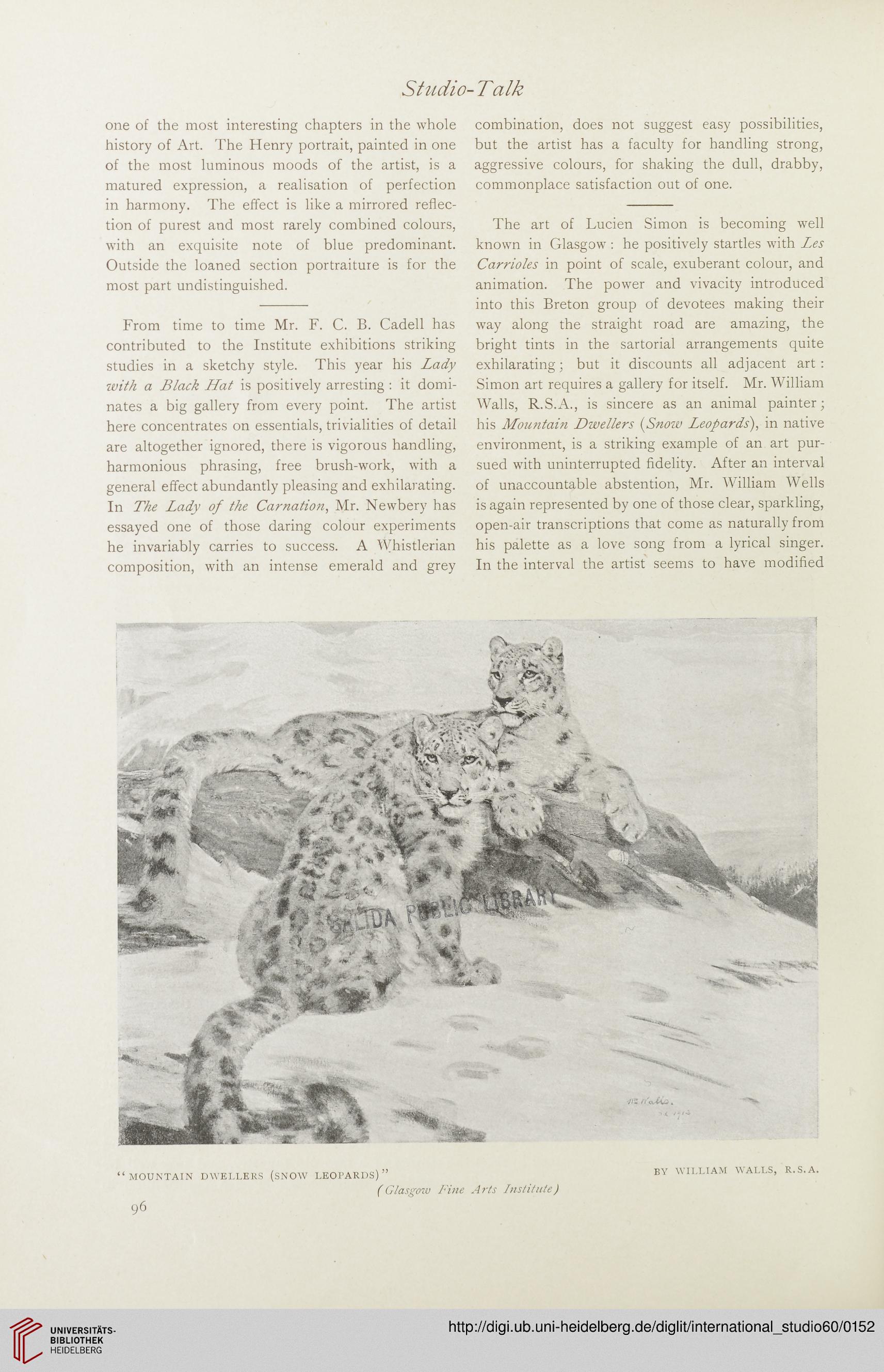Studio-Talk
one of the most interesting chapters in the whole
history of Art. The Henry portrait, painted in one
of the most luminous moods of the artist, is a
matured expression, a realisation of perfection
in harmony. The effect is like a mirrored reflec-
tion of purest and most rarely combined colours,
with an exquisite note of blue predominant.
Outside the loaned section portraiture is for the
most part undistinguished.
From time to time Mr. F. C. B. Cadell has
contributed to the Institute exhibitions striking
studies in a sketchy style. This year his Lady
with a Black Hat is positively arresting : it domi-
nates a big gallery from every point. The artist
here concentrates on essentials, trivialities of detail
are altogether ignored, there is vigorous handling,
harmonious phrasing, free brush-work, with a
general effect abundantly pleasing and exhilarating.
In The Lady of the Carnation, Mr. Newbery has
essayed one of those daring colour experiments
he invariably carries to success. A Whistlerian
composition, with an intense emerald and grey
combination, does not suggest easy possibilities,
but the artist has a faculty for handling strong,
aggressive colours, for shaking the dull, drabby,
commonplace satisfaction out of one.
The art of Lucien Simon is becoming well
known in Glasgow : he positively startles with Les
Carrioles in point of scale, exuberant colour, and
animation. The power and vivacity introduced
into this Breton group of devotees making their
way along the straight road are amazing, the
bright tints in the sartorial arrangements quite
exhilarating; but it discounts all adjacent art:
Simon art requires a gallery for itself. Mr. William
Walls, R.S.A., is sincere as an animal painter;
his Mountain Dwellers (Snow Leopards}, in native
environment, is a striking example of an art pur-
sued with uninterrupted fidelity. After an interval
of unaccountable abstention, Mr. William Wells
is again represented by one of those clear, sparkling,
open-air transcriptions that come as naturally from
his palette as a love song from a lyrical singer.
In the interval the artist seems to have modified
“MOUNTAIN DWELLERS (SNOW LEOPARDS)”
(Glasgow Fine Arts Institute)
96
BY WILLIAM WALLS, R.S.A.
one of the most interesting chapters in the whole
history of Art. The Henry portrait, painted in one
of the most luminous moods of the artist, is a
matured expression, a realisation of perfection
in harmony. The effect is like a mirrored reflec-
tion of purest and most rarely combined colours,
with an exquisite note of blue predominant.
Outside the loaned section portraiture is for the
most part undistinguished.
From time to time Mr. F. C. B. Cadell has
contributed to the Institute exhibitions striking
studies in a sketchy style. This year his Lady
with a Black Hat is positively arresting : it domi-
nates a big gallery from every point. The artist
here concentrates on essentials, trivialities of detail
are altogether ignored, there is vigorous handling,
harmonious phrasing, free brush-work, with a
general effect abundantly pleasing and exhilarating.
In The Lady of the Carnation, Mr. Newbery has
essayed one of those daring colour experiments
he invariably carries to success. A Whistlerian
composition, with an intense emerald and grey
combination, does not suggest easy possibilities,
but the artist has a faculty for handling strong,
aggressive colours, for shaking the dull, drabby,
commonplace satisfaction out of one.
The art of Lucien Simon is becoming well
known in Glasgow : he positively startles with Les
Carrioles in point of scale, exuberant colour, and
animation. The power and vivacity introduced
into this Breton group of devotees making their
way along the straight road are amazing, the
bright tints in the sartorial arrangements quite
exhilarating; but it discounts all adjacent art:
Simon art requires a gallery for itself. Mr. William
Walls, R.S.A., is sincere as an animal painter;
his Mountain Dwellers (Snow Leopards}, in native
environment, is a striking example of an art pur-
sued with uninterrupted fidelity. After an interval
of unaccountable abstention, Mr. William Wells
is again represented by one of those clear, sparkling,
open-air transcriptions that come as naturally from
his palette as a love song from a lyrical singer.
In the interval the artist seems to have modified
“MOUNTAIN DWELLERS (SNOW LEOPARDS)”
(Glasgow Fine Arts Institute)
96
BY WILLIAM WALLS, R.S.A.




